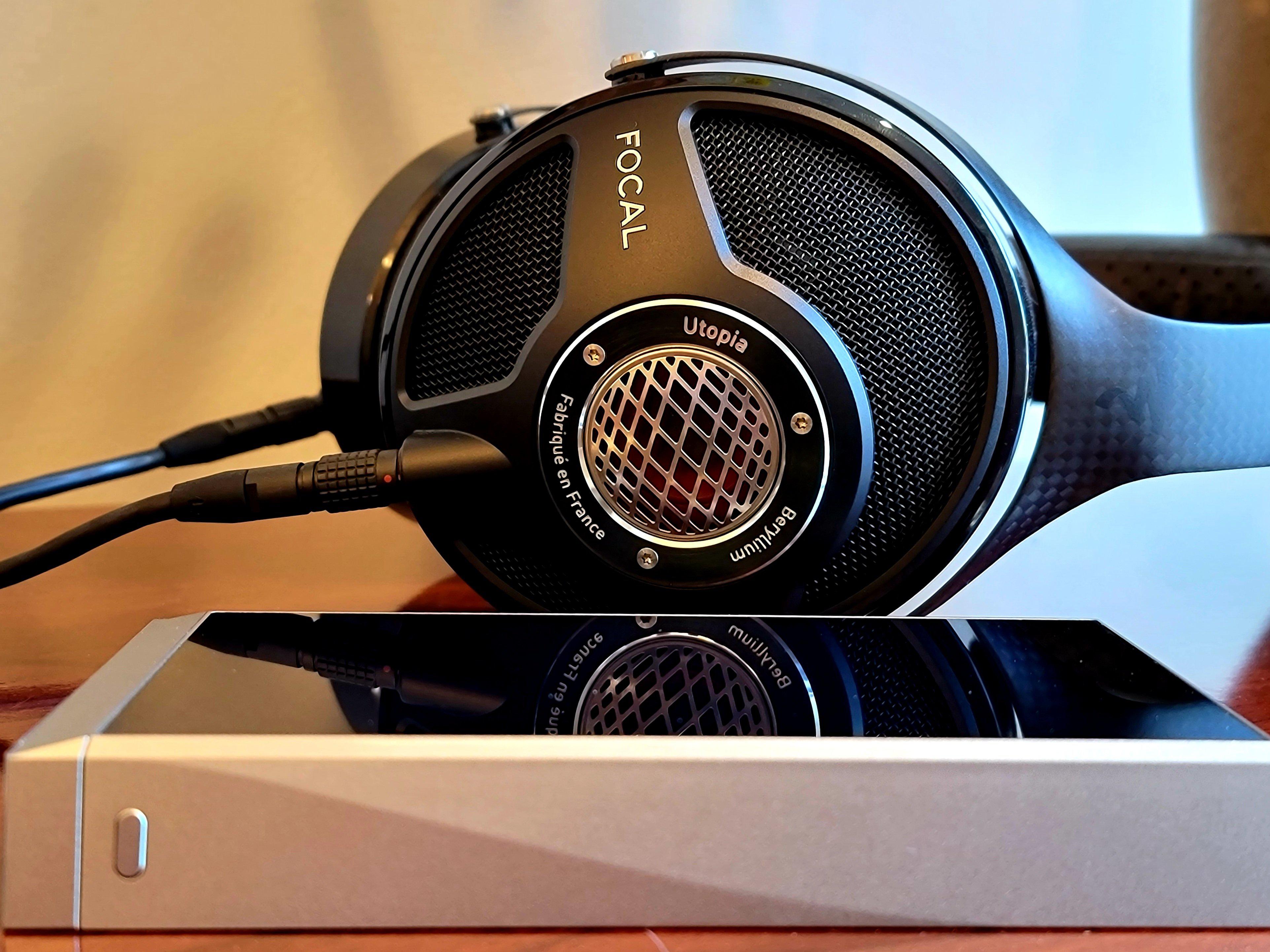Piggybacking off of the SE200’s setup with two discrete DAC and Amp channels, the all-new Astell&Kern SE180 gives us replaceable All-in-One Sound Modules that allow you to have potentially unlimited variety in your DAC/Amp selection in one DAP. While Astell&Kern isn’t the first to try this sort of modular system, it might be the most ambitious implementation we’ve seen yet.
The Look and Feel
With each new player, Astell&Kern further demonstrates their commitment to having a high level of artistry in the designs, as well as the best build quality in the business. The SE180 is no exception, and it has both excellent craftsmanship and a stunning visual design. The player is fairly large, and features the same 5” 1080p screen as the SE200, but with a little extra space needed to accommodate the modules.
While the execution is top notch, I do have one issue with the SE180’s design. Rather than use the standard three buttons for play/pause, skip, and previous on the side of the unit, the SE180 uses a single button which takes 1 click for play/pause, double-click for skip, and TRIPLE-click for previous track. I’m not sure if we’ve just decided that all buttons are bad, and we need less of them, but – while the lack of buttons may aid in providing a sleeker silhouette – it’s a small usability issue for those of us who love our buttons. Of course, the button itself, as well as the volume wheel, are quite nice and provide good tactile feedback. It’s just the function that I’m not a huge fan of.
The removable All-in-One modules are held firmly in place, and can be removed by simultaneously pressing buttons on both sides of the unit, and then gently pulling it out. There’s a bit of resistance to it, and the buttons require a bit of force and precision to press to create the release. In theory, most users won’t be changing it out too frequently, but there’s definitely a bit of dexterity required to do it.
The Interface
The SE180 has some minor UI updates, but mostly keeps the same Astell&Kern interface we all know and love intact. If you’re not familiar with A&K DAPs, the device always opens to the media player app where you can play music stored on the player. You can copy music onto the player with an SD card or by connecting it to a computer over USB. You can also install a number of approved streaming apps by sideloading them onto the device.
The big update to the UI is the addition of a control bar to the bottom of the screen. The control bar shows the info for the current track along with a home button, and controls for play/pause, skip, and previous track. The control bar somewhat mitigates the lack of the three physical buttons, but the screen still needs to be on to use it.
For streaming apps, Astell&Kern has a “whitelist” of apps which you can install, and you’re limited to having eight total installed on the player at any given time. Most of the popular ones including Spotify, Apple Music, TIDAL, and Qobuz are available. TIDAL and Deezer are included out of the box, but the included TIDAL app doesn’t provide the full functionality of the standard app, so most users end up installing the standard TIDAL app separately. Regrettably the control bar at the bottom doesn’t work with streaming apps, so it just provides the home button for any app other than the main player.
The SE180 also has Bluetooth capabilities and can both receive Bluetooth input from another device to function as a streamer and transmit music over Bluetooth to another device – like headphones or a Bluetooth streamer. It can also be used as a USB DAC when plugged into a computer.
The Sound
While we’ve been promised multiple All-in-One sound modules – and the SEM2 is coming soon – at the time of this review, we only have the SEM1 standard module with the ESS9038Pro DAC, so we’ll base our impressions off this “standard” configuration. For testing purposes, I used the Empire Ears Odin, Noble Sultan, Campfire Audio Andromeda, and 64 Audio Nio as reference IEMs, the Focal Utopia and Meze Empyrean for over-ear headphones, and compared sound and performance with the Astell&Kern SE200, KANN Alpha, SA700, and the iBasso DX300.

The tuning of the SE180 with SEM1 is somewhat evocative of the SP2000. While the sound is broadly neutral, there’s a notable smooth, liquid nature to the treble and upper ranges which tames brighter headphones like the Utopia – even providing a non-fatiguing experience with violin heavy Vivaldi pieces – without compromising the detail. It doesn’t quite walk the tightrope between neutral and musical as well as the SP2000 though, nor does it provide the same level of definition in the highs, and it falls a little bit more on the neutral side
The soundstage and 3D image provided by the player is quite good, providing a good sense of space and positioning both with headphones and IEMs. While it’s not able to provide desktop levels of headroom with the Meze Empyrean, it still provides a big open sound befitting the headphones.
Switching between the balanced 4.4mm and 2.5mm and the 3.5mm single ended, it seems that each channel is equally robust. I wasn't able to discern any differences in the presentation between the three with IEMs, but the additional power definitely made a difference with over-ear headphones.
Comparisons
The obvious comparison here is with the SE200, since they’re part of the same series and the SE180 comes in cheaper for DAP itself, but then a little more expensive if you want to add in the option to switch the DAC/Amp card. The SE180 has stronger bass response, and less brightness in the treble than the ESS DAC on the SE200, but the SE200 has stronger detail and definition at the top. Sound is otherwise very similar. The SE180 with the SEM1 really sounds closer to the AKM DAC channel, but I feel like the mids are slightly thicker on the SE200 giving it a little more body.
Compared with the KANN Alpha, I hear a bit more detail and a stronger upper midrange in the SE180, but more powerful, deeper bass in the KANN Alpha. Its power output doesn’t quite match up with the KANN Alpha’s, so it doesn’t quite have the oomph for more powerful headphones, but I wouldn’t be surprised if they came up with some kind of huge KANN DAC/Amp module for this thing at some point.
I also thought it was worth mentioning the SA700, since the SE180 is closing in on its space. I still find the SA700 to have one of the most addictive, musical sounds in its class, but in terms of the detail and technical aspects, the SE180 has the edge. Of course, the smooth, warm sound of the SA700 might just be your style, and the SA700 still has the advantage if you plan on putting it in your pocket.
The iBasso DX300, being the most recent flagship from iBasso, also provides really strong competition for the SE180. But in a lot of ways, comparing Astell&Kern and iBasso players has become somewhat of an “apples to oranges” comparison. iBasso’s use of a completely open Android OS means that the installation of apps and the configuration of the device for use as anything other than a pure music player for playing local files is much easier on the DX300. On the flipside, the build quality and artistic design of the SE180 is on a whole different level, and as a simple player, the interface and function is stronger.
Of course, with those clear differences, it’s interesting that they would share one key feature: both units have a modular system for altering the sound and the performance of the devices with swappable cards. The DX300 keeps the DAC intact, and allows you to replace the amp, while the SE180 combines the DAC and Amp into one. Both are just a little too fresh to really evaluate this feature, but it has some promise for increasing the longevity of the device as well as giving you more options for tweaking the sound.
We haven’t even started talking about the sound, but you may have already made your decision already just based on the basic build and operation of the devices. There is an interesting sort of switch with the sort, where Astell&Kern is known for having subtle musical adjustments to their tunings, while iBasso has traditionally had a more neutral sound. Here the DX300 leans more in the “musical” direction when compared to the SE180. The main similarity is in the treble, where both have a smoother, silkier top end, and the main difference is in the bass where the DX300 provides a stronger low-end response.
The Bottom Line
As a player at $1499, the SE180 provides all of the qualities and technical capabilities that you have come to expect from Astell&Kern, and is a solid pick. But the SE180 is more than that: its All-in-One module system promises a step forward for DAP technology. If Astell&Kern is going to commit to this new tech, the SE180 could have a promising future as one of the most versatile DAPs we’ve ever seen.









